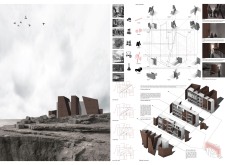5 key facts about this project
The architectural design addresses important themes around gender equality in a multi-level structure. Situated thoughtfully to encourage interaction with its surroundings, the building has distinct functional areas. The fourth floor is designated mainly for office use, while the second and third floors house exhibition spaces that reflect on historical narratives. The overall concept integrates past experiences with present objectives, aiming to initiate conversations about societal changes in gender roles.
Exhibition Spaces
The third-floor exhibition hall stands out with its rotating wall, creating a unique experience for visitors. This feature allows for varied views and interactions with the displays, enriching how people engage with the material. The double-height area enhances visibility, encouraging exploration and participation in the themes presented. Visitors can easily move between displays, connecting historical insights with modern discussions.
Historical Context
On the second floor, the exhibition halls present walls of different heights, symbolizing the complexities faced by women throughout history, particularly during the Middle Ages. This arrangement serves a narrative purpose, guiding visitors through the various challenges women experienced, including unjust accusations of witchcraft against those who excelled in their fields. Each space reflects specific stories, illustrating the struggles and contributions of women in diverse contexts.
Spatial Organization
The entrance, which features a four-story double-height space, plays a critical role in linking the various parts of the building. This significant area acts as a focal point, reflecting the cultural impact of Notre Dame and the elevated status that some women historically held. The design promotes an easy flow between office spaces and exhibitions, ensuring that visitors can navigate the building with ease.
Design Detail
An interesting aspect of the interior design can be found in Node C, where a "crack" divides the space into two sections. This division highlights themes of persecution and separation, drawing attention to historical injustices. It invites visitors to consider the societal values depicted in the exhibits and encourages critical reflection on gender equality, making the building not just a place to visit but also a space for engagement with essential social themes.


















































